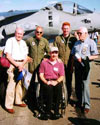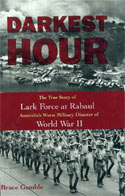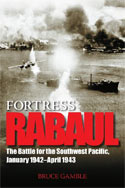Bruce Gamble
Author Interview
|
Tell a little about yourself and your background
I grew up in Pennsylvania and attended Aviation
Officer Candidate School after graduating from Penn State. Following
my commissioning at Pensacola, FL, I went to flight school and was winged
as a Naval Flight Officer in 1982. I flew as navigator aboard EA-3B
Skywarriors for three years, then returned to Pensacola as an instructor
in T-47 Citation II jets. In 1988 I was medically retired due to a spinal
cord tumor, so I began volunteering at the National Museum of Naval
Aviation (NMNA). Shortly thereafter, I began to write for the museum's
magazine, Foundation.
How did you get interested in
the Pacific Theater?
I have a lifelong interest in both topics, which
became stronger as I began collecting oral histories of navy and marine
pilots. I concentrated on veterans of the Pacific war, publishing several
of their stories in Foundation magazine.
My father was a B-29 pilot stationed at Northwest
Field on Guam. He flew missions over Japanese oil refineries using the
APQ-7 Eagle radar for night bombing. As a youngster I was fascinated
by his collection of photos and documents, including a diary he kept.
During my own military service, I was stationed at NAS Agana
and was able to drive around the abandoned airfield where he had been
based. I doubt many individuals get to experience such a connection.
Furthermore, my birthday-December 7-always had significance to me.
|

Bruce Gamble with
Marine pilots with AV-8 Harrier II
|
What got you interested in the Black Sheep VMB-214?
While collecting oral histories for the NMNA,
I interviewed John F. Bolt, one of the original Black Sheep. Later
he arranged for me to join the squadron's 50th anniversary reunion,
held at New Orleans in 1993. I interviewed twenty of the veterans,
then began gathering documents and photographs to accompany their
recollections. From this assortment of material came THE
BLACK SHEEP, published by Presidio Press in 1998.
My intention was to tell of the service performed
by the three incarnations of VMF-214 not just the exploits of Pappy
Boyington. Those have been batted around for many years, and I was
amazed at how many myths and pieces of misinformation had become
accepted as factual. Two years later, I followed up with a full-life
biography of Boyington, which had never been done before. BLACK
SHEEP ONE was published in December 2000.
I attended two VMF-214 reunions. The first lasted an entire week, in May, 1993.
It was attended by some twenty original members, including the flight
surgeon and intelligence officer. I attended another reunion in November,
2000, also in New Orleans, joined by 13 pilots. Quite a few had died
since '93.
I remember vividly when the made-for-TV movie "Black Sheep" premiered
in September 1976, as I lived in a Penn State dormitory at the time. Now
we're on the eve of the 25th anniversary. The show was (and remains-on
The History Channel) fun, especially the scenes involving F4U Corsairs.
From a factual standpoint, Robert Conrad's attitude and personality were
a good match for Boyington's, but the plots themselves were farfetched.
Boyington's participation in the "misfits and outcasts" theme
for the sake of money rankled most of the Black Sheep, but they eventually
forgave him. As for "Pearl Harbor," I'll have to hold my opinions
until I see the movie. Folks should remember the number one reason why
such films are made: entertainment. Those who are nitpicky about small
details will never be satisfied.
|

The Black Sheep

Black Sheep One
|
Speak a little bit about researching and writing your books.
I enjoy interviewing veterans, who all have numerous
fascinating stories to tell-some funny, some grim. At the same time,
I'm something of a skeptic. I treat every anecdote as a "sea story"
until I find other documentation to back it up. If stories are confirmed,
they gain much more impact. I stay away from tales that seem embellished
or flamboyant. Finally, I try to weave these examples and anecdotes
into the larger fabric of the manuscript, giving authenticity to whatever
point I'm making. As for other sources, much can be gleaned from photographs,
and most pilots kept log books that can be measured against squadron
documents-war diaries, for example. Quite a bit of documentation was
available regarding VMF-214. In the case of Gregory Boyington, I acquired
his complete service record and medical history, plus his aviation training
records, courtesy of his son. With those records, huge gaps would have
existed in his story.
My own naval flying background certainly helped.
Also, I grew up reading A Bridge Too Far and The Longest Day, both by
Cornelius Ryan, and I loved how he presented the story of the "little
guy" along with the larger picture. I tried to emulate him by writing
about individual pilots and their experiences. I think this is what
makes historical books entertaining. Writing about tactics and strategy
alone can be pretty dull.
I consider Henry
Sakaida a real friend. He was very
enthusiastic about helping. He provided pages of his research records
without ever asking what was in it for him-he truly wanted to see the
Black Sheep's history told as accurately as possible. Without Henry's
help, the book would have been one-dimensional. I am indebted to him.
I'm also glad to say that he helped just as willingly on my second book,
Black Sheep One: The Life of Gregory "Pappy" Boyington, and
he's assisting me on my next book, which will be about Rabaul.
Because of my disability, I cannot
travel to such far-off places without serious health risks. However,
I did rely on my experiences in the Pacific while I was a navy flier.
The conditions in the tropics are similar throughout the Pacific.
|
|
Any upcoming projects you want
to mention?
I am gathering the documentation and interviews
for books on Rabaul.
The first will cover the fall of Rabaul when the Japanese overran the Australians
in January 1942, and the fate of the small force garrisoned there.
Then
the story will shift to the Allied bombing campaign, with details about
some of the individuals who were shot down during these hazardous attacks
(some men were captured, while others hid out for months thanks to Australian
coastwatchers and their network of helpful natives). The book will also
cover the POWs at Rabaul and will conclude with the final surrender
by the Japanese aboard HMS Glory in 1945. Fortress Rabaul: The Battle for the Southwest Pacific, January 1942-April 1943
I was retired unexpectedly at the age of 30, but
my new career as a researcher and writer of World War II history has
been extremely rewarding. It has been my privilege to meet more than
20 of the original Black Sheep, and I'm grateful for their support and
continued friendship. Readers might want to watch The History Channel
on November 29 at 8 p.m. Eastern, when a new documentary called "The
True Story of the Black Sheep" will premiere.
Thank you for the interview, Mr. Gamble.
List of books by Bruce Gamble
List of books by Bruce Gamble include:
|

Darkest Hour

Fortress Rabaul

Target Rabaul
|
|